If you’re like most people, you probably think that stevia and stevia extract are one and the same. After all, they’re both derived from the same plant, so how different could they really be? As it turns out, there is a big difference between the two, and it all has to do with processing.
And believe it or not, you can make your own stevia extract right at home! It’s easier to do than you might think.
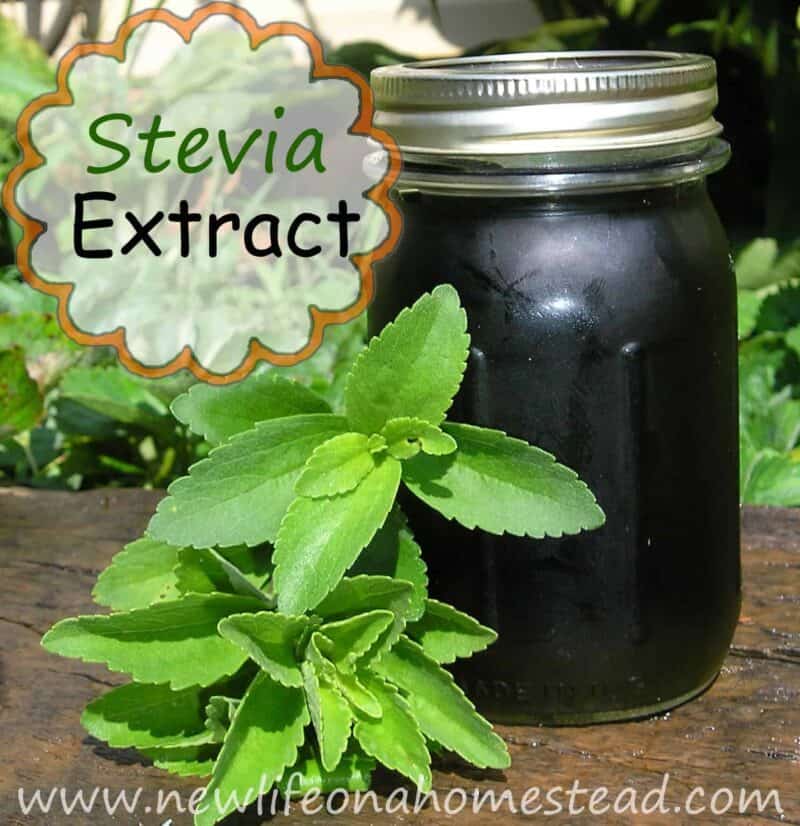
Benefits of Stevia
Stevia is a popular herbal sweetener that comes from the stevia plant. The stevia plant is native to South America and has been used as a sweetener for centuries. Today, stevia is grown all over the world and is a common ingredient in many processed foods and beverages.
The leaves of the stevia plant are around 30 times sweeter than sugar, making it a popular choice for people looking for a sugar alternative.
There are two main types of stevia: Rebaudioside A (Reb A) and Stevioside. Reb A is the more commonly used form of stevia as it has little to no aftertaste, unlike Stevioside.
One of the main benefits of stevia is that it is calorie-free, making it an ideal sweetener for people watching their weight or their blood sugar levels. It is lower in carbs and absolutely delicious, too!
Additionally, stevia can help lower blood pressure and has been shown to be anti-cariogenic, meaning that it can help prevent cavities.
What is the Difference Between Stevia and Stevia Extract?
Stevia is a plant that is native to South America. The leaves of the plant have been used for centuries as a natural sweetener. In its natural form, stevia is up to 300 times sweeter than sugar.
However, it should be noted that the degree of sweetness can vary depending on the variety of stevia plant and how the various syrups are made.
Stevia extract is derived from the stevia plant through a process of extraction and purification. This process removes many of the impurities that are present in the plant’s leaves, resulting in a more concentrated form of sweetness. As a result, stevia extract is typically 200-400 times sweeter than sugar.
Two Methods of Making Stevia Extract – With Water and With Alcohol
There are two methods for making stevia extract – with water and with alcohol. Here’s a quick overview of each method.
In this post, I’ll walk you through the method of making stevia with water instead of alcohol, but I think it’s important to understand how both options work.
If you’re interested in making your own stevia extract at home, you might be wondering whether to use water or alcohol as the base. There are pros and cons to both methods, but overall, using water is a better option.
The first reason to make stevia extract with water instead of alcohol is that water is a better solvent. This means that it will more effectively extract the desired compounds from the stevia leaves. As a result, you’ll end up with a more potent extract.
Water is also less likely to damage the delicate compounds in stevia leaves. This is especially important if you’re planning on using the extract for culinary purposes, as damaged compounds can result in an off-flavor.
As we just mentioned, one of the benefits of using water as a solvent is that it’s less likely to damage the delicate compounds in stevia leaves. Alcohol, on the other hand, is more likely to damage these compounds.
In addition, alcohol will also extract bitter compounds along with the sweet ones. This can result in an extract that is less than pleasant to taste with a bitter aftertaste.
If you do choose to use alcohol as your solvent, be sure to use a high-proof variety so that you can more easily remove it during the evaporation process. This will let you get all the sweetness of sugar without the down side of the alcohol.
If you choose to make stevia extract with alcohol, you’ll start by chopping up your stevia leaves. You’ll need about 4 ounces of chopped leaves for every cup of alcohol (usually vodka is the alcohol used). Add the chopped leaves to a jar or bottle, then pour in the alcohol.
Seal the jar or bottle tightly and store it in a cool, dark place for at least 2 weeks. After 2 weeks, strain the liquid into another container and discard the solids.
Your stevia extract is now ready to use! This method takes a bit longer, but it results in a more concentrated extract that will last longer once made.
What Part of the Plant Do You Use to Make Stevia Extract?
To make stevia extract, the leaves of the stevia plant are dried and then steeped in water. The resulting solution is then filtered to remove any solids. The extract can be used in a variety of ways, such as sweetening beverages or baking recipes.
Some people also prefer to add liquid stevia extract to their coffee or tea for a more natural sweetness. While the leaves of the stevia plant are the most commonly used part to make extract, the flowers and stems can also be used.
However, these parts of the plant are less bitter than the leaves, so they may not provide as much of a sweet flavor.
How to Make Stevia Extract With Water – Step by Step
Today I spent some time experimenting with my Stevia. I finally have enough leaves on the plant this year to do some playing around.
I’ve been wanting to learn to use fresh Stevia to sweeten a good part of my baked goods and teas, so I harvested about 2/3 of my plants and got busy in the kitchen.
How to Harvest Stevia Leaves
The best time to harvest stevia leaves is in the morning after the dew has evaporated but before the sun gets too hot. You can either pick the leaves by hand or use a sharp knife or pair of scissors to cut them from the stem. Be sure to only take a few leaves from each plant so that it can continue to grow.
Once you’ve harvested your stevia leaves, you can use them fresh or dried. For making stevia extract, you’ll want to use fresh leaves.
Wash the Stevia Leaves
It has been quite rainy here, which you would think would clean the plants, but since I don’t have much mulch around the base of my Stevia the mud splashed up off the ground and got the undersides of the lower leaves on the plant dirty.
So, my first order of business was to wash the freshly picked Stevia. To do this I filled my sink with cold water, and swished the leaves around in it:
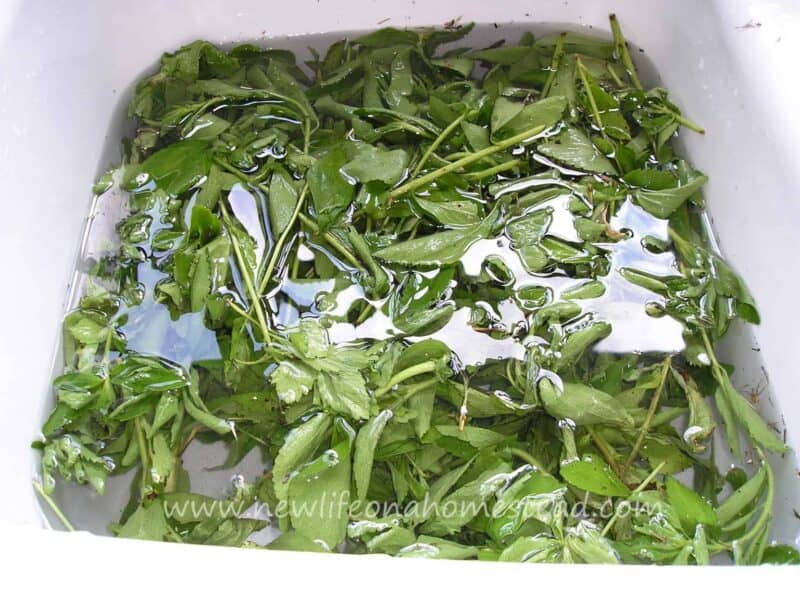
I then drained the dirty water out and filled the sink for one more rinse:
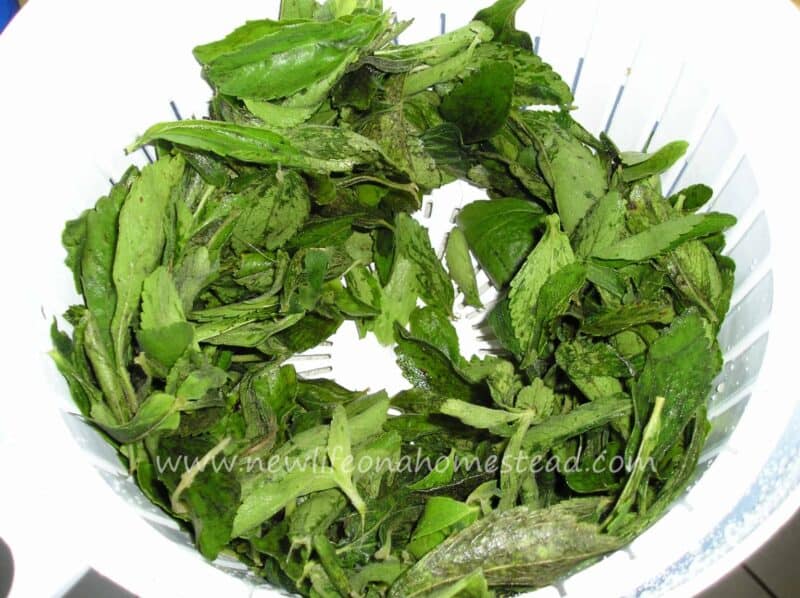
Trim and Discard Leaves
Next, I discarded the stems, and spun the leaves in a salad spinner to remove the excess water. You’ll want to pick out any dead or bad looking leaves. Some of my leaves had brown spots on them, but if they weren’t too bad I kept them in with the rest.
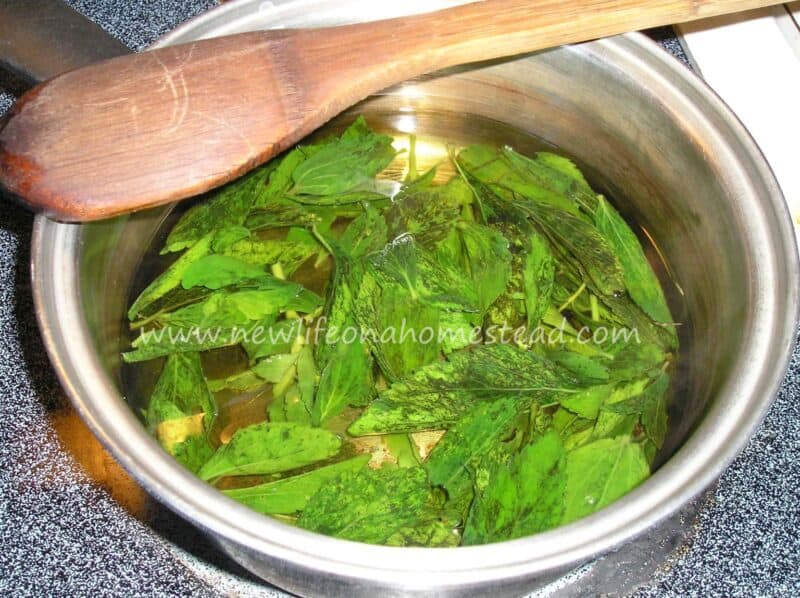
“Almost” Boil Water
In a medium sized pot, get 2 cups of water almost to a boil. Be sure not to bring it to a full boil, as this can damage the Stevia.
Add 1 cup of slightly bruised leaves (they will probably be bruised already from the washing and spinning if you go through those steps), and remove the pot from the heat. Cover, and allow to steep for about an hour.
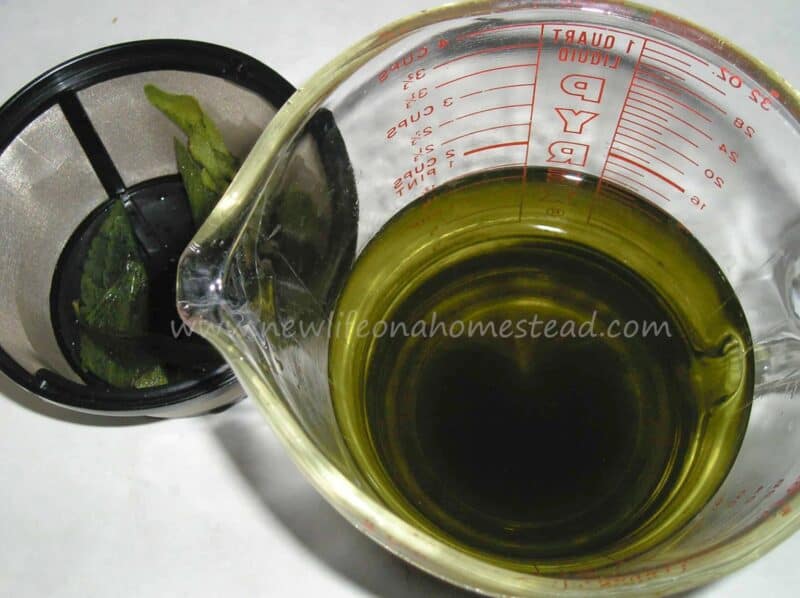
Strain
Using a coffee filter or piece of cheesecloth, strain the liquid into a clean container. It’ll be a nice, greenish color. Store your homemade liquid Stevia extract in a glass container in the fridge for up to 2 weeks.
Stevia Extract Recipe
Equipment
- mason jar with lid
- salad spinner
- coffee filter
Ingredients
- 1 cup stevia leaves
- water
Instructions
- In a medium sized pot, get 2 cups of water almost to a boil. Be sure not to bring it to a full boil.
- Add the Stevia leaves.
- Remove the pot from the heat.
- Cover, and allow to steep for 60 minutes.
- Using a coffee filter, strain the liquid tincture into a clean container.
How Do You Make Homemade Stevia Sugar?
Looking for one more way to use up all those stevia leaves?
Making your own stevia sugar is a great way to enjoy the sweetness of stevia without any of the potential side effects that come with other sweeteners. And it’s easy to do!
Simply mix 1 part stevia powder with 2 parts cane sugar, and voila – you have homemade stevia sugar. The ratio can be adjusted to taste, so feel free to experiment until you find the perfect level of sweetness.
It’s not quite the same as just regular stevia that you might buy at the store, but it’s an easy swap you can make at home for better health.
Not only is this sugar healthier than refined cane sugar, but it also has a more complex flavor that is perfect for baking.
How Long Does Homemade Stevia Extract Last?
It’s recommended that you store the extract in a dark container, but I didn’t have one so I put my jar in a brown paper bag instead.
Before putting my finished product up, we all tasted a sample of it. Whew, was it SWEET!
I’m anxious to use my extract in some new recipes. For a few recipe ideas, check out Mother Earth News’ Article, Naturally Sweet Stevia Recipes.
How to Use Stevia Leaves in Baking
If you’re interested in using stevia leaves in your baking, here are a few tips to get you started.
- Start with fresh or frozen stevia leaves. If you can’t find fresh stevia leaves, they can also be used frozen. You’ll need about 10 leaves for every cup of sugar you’re substituting.
- Stevia leaves can be used whole or ground up. If you’re using whole leaves, simply add them directly to your recipe. If you’re using ground stevia leaves, add them along with other dry ingredients such as flour and spices.
- When substituting stevia leaves for sugar, honey, or maple syrup in baking recipes, keep in mind that the leaves will not dissociate in liquid like sugar does. As a result, your baked goods may not rise as much as they would if made with sugar. To help combat this, add an extra 1/4 teaspoon of baking powder per cup of stevia used.
- Stevia leaf extract can also be used in low carb baking recipes in place of sugar. Simply substitute 1 teaspoon of extract for every 1 cup of sugar called for in the recipe.
- Finally, remember that because stevia is much sweeter than sugar, you’ll need to use less of it to achieve the same level of sweetness. When in doubt, start by substituting half the amount of sugar called for with stevia and then adjust from there according to taste.
Have you used homemade Stevia extract in your baking or to sweeten drinks? I’d love to know how you’re using it, and any advice you can share!

A city girl learning to homestead on an acre of land in the country. Wife and homeschooling mother of four. Enjoying life, and everything that has to do with self sufficient living.

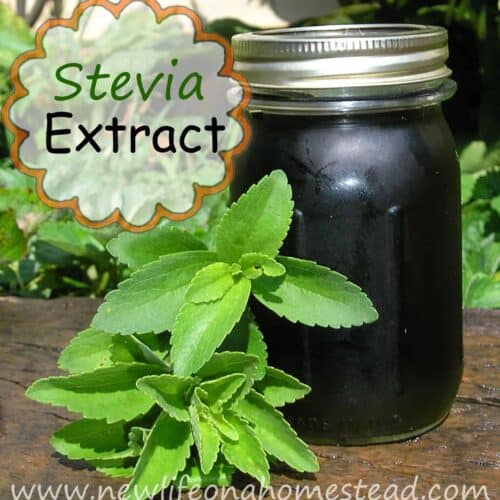
I tried this but my liquid came out brown instead of green does that mean it’s more bitter?
Will using this homemade stevie liquid displace other liquid in a recipe? Thanks.
Just wanted to clarify that this is actually not an extract, but an infusion. Infusions are plant material steeped in water or oil, and an extract is achieved in alcohol and/or glycerin and water. Extracts are often left to steep for a few weeks, shaking daily, before straining. I often use 1/2 grain alcohol 1/2 water or 1/3 grain alcohol 1/3 water 1/3 glycerin. They will keep for a very long time!
Oops, saw you’d answered a question about ice cubes. I bought large plants at our local ‘Wal’ of China store this week, and more at the grocery store. I see that seeds are available online and through seed companies. I deal with companies that sell heirloom and non-GMO seeds.
I wonder if this concoction, in larger amounts, could be frozen as ice cubes and thawed as needed.
Stevia can you dehighdrait them and make sweetner for use in winter.
Did you ever do any baking with your stevia extract and how did things go? Did you start your plants from seed or purchase them already growing? I’ve tried starting from seed and haven’t seem to have had any luck getting them to grow.
You know Johnna, I never did bake with it. I used it up making tea. 🙂 Mine were plants that were given to me from a local nursery. I hope you’re able to get some growing! They’re so much fun.
You can order seeds from Baker Creek Seeds.
I am interested in getting some stevia plants. Please let me know where I can buy them at!
Burpee.com sells Stevia 🙂
Most local green houses sell them. We got really nice plants this year. Having trouble keeping up with them.
Where can I get seeds or a plant ?
M.J.- Burpee.com sells Stevia 🙂
I have also heard about drying the leaves on a very low heat in the oven. Just heat the oven on low. Put your leaves on a baking pan and turn the oven off. Put the pan in the oven and let sit over night. Next day you can use a mortar and pestal or coffee grinder reserved for herbs to make it into a powder. I want to try this this year. It is suppose to be really sweet and healthier. However, it will turn your product green. Also will be really sweet. Will not need much to sweeten.
I apologize if this was mentioned. Can you freeze the extract? Thanks.
Gina, yes, you can freeze it in small amounts, like ice cube trays.
I wonder if you could put stevia leaves thru a masticating juicer and use the extracted juice?
Also has anyone used the dried stems for anything?
I have planted four stevia plants but as we are counting down to Autumn I may not get much off them before Winter hits.
Wendy NZ- I’m not sure how a juicer would do. And I’ve only used the leaves. Let us know if you experiment with it!
I was told not to use the stems, they will make your extract bitter. Of course I forgot this piece of info the first time I dried and ground my leaves. Ruined the whole batch 🙁
I use stevia in my freezer jams and apple butter. I reduce the amount of sugar required by half using stevia. I also plan to grow my own stevia this spring as I use it in almost everything including making cookies.
That’s a good tip, Shawna! I like the idea of going half and half as you get used to the taste. 🙂
I grew stevia last year but I did not do anything with it. I hope it comes back in the spring. We live in North Mississippi.
I hope you can get some to grow for you, Norma!
Pls, where can I get stevia plant or leaves?.
adeyinka- you can find Stevia plants for sale at Burpee.com 🙂
I washed my stevia leaves and dried them in the oven on a very low temp (150 +/-). After fully dried, I pulverized them in my coffee/spice grinder…very fine powder. Haven’t baked with it but use in tea, etc. A little green residue floats to top, but no big deal. I like the dehydrated better than fresh.
You can can with stevia, just as you can can with other artificial sweeteners. However, you need a special pectin to do it well. There’s a Ball no sugar pectin, but probably the best choice is Pomona Pectin, which allows you to use as much or as little sugar as you prefer, or substitute other choices for sugar instead.
With most pectins, you need the sugar to activate the gelling action so you can’t alter the recipe or lower the amount of sugar. With Pomona, it uses a different method of gelling so you can alter the amount or type of sweetener at will.
I wrote all about pectin types and mechanisms of action here:
http://wellroundedmama.blogspot.com/2012/09/canning-pecking-about-pectins.html
Personally I don’t care for stevia for canning but it is good for other things, so it’s worth it to explore making extracts from it.
Very interesting! I’ll be curious to read how you use it in recipes. Will it turn baked goods green? And if you steep it in vodka, would the extra last longer (like making vanilla extract)?
KK
I have 3 Stevia plants that have taken off this year. I live in the panhandle of Fl and we have had a very wet summer and they are doing great. I have cut them back several times and they just get bushier and taller. I have made a Stevia tincture with 100 proof vodka that is really greatand in a dark bottle/dark place it will keep for a couple of years with out refrigeration. I have only used it to sweeten my other tinctures, I am an herbalist and have several
(dozen) tinctures. I bet it can be used like vanilla extract. Also if you dry the leaves then grind them up really fine you can use them like sugar, but they make the food kind of green and yuo have to just keep trying to see about the sweetness.
Great info, Krista!
If you are using vodka for tinctures what do you do with it besides drink it, can you use it in tea, coffee or cook with it?
Hi Kendra. Wow, I’ve never even thought about growing and making my own stevia extract. What a great idea. I just got my mint plant to finally take off. Everyone laughs because they are so prolific and take over the garden, but my was really struggling for the first couple of years.
Just curious, how do compare the taste and sweetness of your homemade liquid to that the you buy in the dropper bottles?
Shawn,
I’ve never tried the store bought extract, so I don’t really know how they compare. The flavor of the extract I made is quite strong. Very sweet, but a different sweet than sugar. You should try growing Stevia! Mine has been super easy to grow, and has really been fun to play with.
Can you make icecubes out of it and freeze them?
Yep. Sure can, Diane 🙂
I must be doing something wrong … I find stevia to be really bitter. Yes, there is a sweet flavor, but the bitter is always there and makes the taste quite unpleasant. Commercial stevia is less bitter, but that under-taste is always there. How do you get used to the bitterness?
Sunny,
My plant isn’t bitter, but there is an aftertaste. My children love to go out and pick several leaves to chew on as they play, so they don’t seem to taste any unpleasantness either. Your plant might be lacking certain nutrients. Also, there are many different varieties of the Stevia plant, and some are sweeter than others.
This is fantastic! I made stevia extract using vodka (you can check out what I did on my blog: http://cradlerockingmama.com/homemade-stevia-extract/) but this sounds like it gets a whole lot more extract for the effort! Have you made stevia extract with vodka before? I’m wondering how the two compare.
Either way, I think I’ll give your method a try next time! Thanks for the tutorial!!
Hi Carrie! No, I haven’t tried using Vodka yet. I would be curious to see which one works best though 🙂 At least with the vodka the extract would last much longer, unless you freeze it. Let me know if you try this method! 🙂
Oh Kendra,
I forgot to say…
I am sure that you already know this,
but stevia can sweeten tea or tinctures or that sort of thing by just adding a few fresh leaves.
Elise
Hi Kendra,
I have been following your blog for some time now and I finally have a question!:)
How can you keep your stevia extract for more than 2 weeks?
Thank you for all your help and wisdom you share.
Elise
Hi Elise! You can freeze liquid stevia in ice cube trays to make it last longer 🙂 As for sweetening with fresh leaves, I’ve actually found that it takes a LOT of fresh leaves to sweeten a cup of tea. I’m sure it depends on preference as well. 🙂
How many cups of fresh leaves do you need to do this with 2 cups of nearly boiling water?
can’t wait! 🙂
Jenn
It’s 1 cup of leaves to 2 cups of water 🙂
I love doing things like this myself – saves so much money!
very interesting post … will have to give it a try 🙂
Could you freeze this into mini muffin tin sizes to keep it longer? I guess I wouldn’t need to make such a big batch for it to make that much. I don’t use stevia or sugar for that much, that often so I wouldn’t need that much and it’s only my hubby and I for now. I guess I could give some to friends to if needed. Just a thought….would it get stronger/bitter like you were saying with the canning thing too?
Also, where do you get your stevia plants at? I would love to try this….you could probably even make sun tea with fresh mint and a few leaves of the stevia then it’s already sweetened and you wouldn’t need to add anymore- oooh, new idea for our new house in a few months!
Katie,
I’ve read other people talking about freezing their stevia extract, so I think it would work fine. Check out the post I wrote about how I make Peppermint Tea with Fresh Stevia!
I just bought another Stevia plant after my chickens ate the first one I got. I’m anxious to try this to see how it works as a sweetener for baking and iced teas. Thanks…..
Blessings,
Michelle
Michelle,
Oh yes, definitely keep those rascally chickens away 🙂 They’re bad about doing stuff like that.
i’m wondering whether or not stevia can be used in “canning” recipes… i belong to a canning club, and we usually use sugar & sometimes splenda; but, no one knows whether we can use stevia in it. one of our former members had contacted “Ball” to find out whether u could substitute; but never got a response (she’s no longer in the group, so don’t know if she heard from them later).
do u know if it can be used in canning?
also, “practical”: my stevia plants have survived over the winter down in southern AL (baldwin county, near the coast). the first year i had some, i brought them inside & they all died. some that i thought that had died & were left outside, came back. they die off & come back, as many other herbs do.
Monica,
I just don’t know if you can can with fresh stevia or not. I know Ball has come out with a new pectin that you can use for sugar-free or alternative sweetener jellies, and you could probably use stevia in that. Definitely store-bought stevia. But I’m thinking if you can with homemade stevia (which will not have anything added to it) the flavor *might* get stronger as it sits, and possibly bitter. Just guessing here. It would be fun to experiment with, though!
how many plants do you have? I have been wanting to do this! we live in the bible belt and we get all 4 seasons…how does stevia do with cold wind, rain and snow?
Shelby,
We’re probably not too far from where you are, we’re in the Southeast. We have 2 plants, and they’ve done very well through our rainy springs, hot/humid summers, and mild winters. They die back and go dormant through the winter, and then pop back up through the ground in Spring.
Why spin out the excess water, then place them into 2 cups of water? I don’t have a spinner and I don’t want to buy one if I don’t need one.
Christopher de Vidal,
You know, I really only spun it because I was processing a large batch, and some of the stevia was going to be dried. So, I guess it really doesn’t have to be spun out if you’re gonna put it right into simmered water. You just don’t want to let it sit out wet for a while, or it’ll start to mildew. Thanks for the great question!
I bought a stevia plant about two months ago. I almost let it die. It recovered. whew. I am going to bring it indoors this winter. I don’t think it would survive the north AL winters.
It’d be great if you can keep the plant alive, Practical Parsimony 🙂